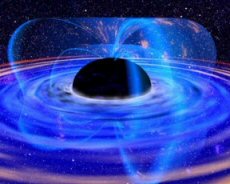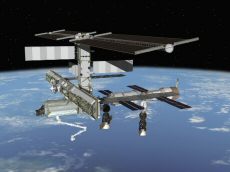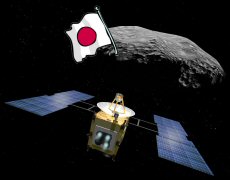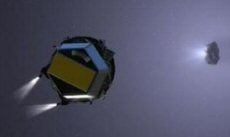 Space (Pre 2008)
Space (Pre 2008)
19 December 2007
Tunguska Revisited
It's not the size that matters; it's what you do with it. Supercomputer simulations of the Tunguska impact have revealed the asteroid to be considerably smaller than previously thought...
6 December 2007
Dwarf Star Activity Puzzles Astronomers
Astronomers have been observing an unusual M-dwarf star with an extremely active and complex magnetic field that is stronger than our own Sun's, and a huge hydrogen hot-spot that covers half of its surface...
19 November 2007
 Sexing Up UFOs
Sexing Up UFOs
You could argue that the concept of Earth-visiting aliens is to science what Intelligent Design is to creationism. That is, both world-views exploit such unlikely and improbable speculations to forward scientific research and theological teaching - though obviously in very different ways. Why, for instance, do you rarely hear scientists come out and explain how unlikely it is that intelligent civilizations are visiting Earth?
25 October 2007
Balloon-Borne Solar Telescope Reaches 120,000 Feet
The National Center for Atmospheric Research has successfully launched a solar telescope to an altitude of 120,000 feet, borne by a balloon larger than a jumbo jet...
11 October 2007
Exotic Form Of Carbon Dioxide Cranks Up Greenhouse Effect On Venus
Planetary scientists have tracked down a rare molecule in the atmosphere of Venus that they believe could affect the way the greenhouse effect works on the planet...
5 October 2007
 The Space Race's Softer Side
The Space Race's Softer Side
This month Vienna will play host to the first ever "comprehensive trans-disciplinary dialogue on humans in outer space" - or so the blurb goes. The rationale behind the conference is to see what a meeting of minds between scientists and representatives from the humanities can produce (obligatory slippers, tweed jackets and pipes on all shuttle flights, perhaps)...
25 September 2007
Super Bacteria Created In Zero-Gravity
Space flight doesn't just affect human physiology; it can also make microbes much more infectious...
14 September 2007
New Insights Into Early Star Formation
A new computer model suggests that the formation of the first stars depended crucially on the nature of dark matter...
16 August 2007
"Hot" Comets The Source Of Life?
A study finding it overwhelmingly likely that life came to Earth inside a radioactive comet with a liquid water core may prompt more astrobiologists to jump on the panspermia bandwagon...
15 August 2007
Physicists Mull Whether Inorganic Dust Formations Could Be Alive
Physicists have found intriguing new evidence of life-like double-helix structures formed from inorganic substances in space...
30 July 2007
New Class Of Galactic Nuclei Identified
Astronomers have discovered what appears to be a relatively common, but previously unidentified, class of active galactic nuclei...
25 June 2007
Satellites Open To Amateur Attack
A new report says that college students with access to an intermediate range rocket could knock-out military or civilian satellites...
22 June 2007
 Rethinking Black Holes
Rethinking Black Holes
General relativity and quantum mechanics are uncomfortable bedfellows when it comes to explaining black hole formation and a number of researchers now contend that black holes may not actually fully form at all...
16 May 2007
Galactic Cluster Collision Sheds Light On Dark Matter
The collision between two galactic clusters, creating what scientists believe is an enormous ring-shaped ripple of dark matter, is providing an unprecedented opportunity to investigate how the elusive substance responds to gravity...
11 May 2007
Star Shows Its Age
Astronomers have accurately dated a star that formed at the dawn of time - a mere 500 million years after the Big Bang...
27 April 2007
 Take Me To Your Lame Duck President
Take Me To Your Lame Duck President
With the recent discovery of the Earth-like planet orbiting Gliese 581, comes renewed speculation about the possibility of making contact with an extraterrestrial intelligence. Somewhat tellingly, immediately after the Gliese 581 discovery, puny Earthling bookmakers lowered the odds of us stumbling upon aliens from 1,000/1 to 100/1...
25 April 2007
An Exoplanet With Liquid Water?
European astronomers say they have detected a distant Earth-like planet with conditions that might allow liquid water to exist...
12 April 2007
Exoplanet Imager Takes Shape
NASA researchers have cobbled together a device that could allow space telescopes to take photographs of planets in other solar systems...
9 April 2007
Astrophysicists Ponder Giant Cosmic Hiccup
Powerful beams of X-rays emanating from a magnetar have astrophysicists wondering what could cause such a massive starquake...
19 March 2007
Martian Caves Could Harbor Life
Analyzing images from Mars Odyssey, scientists believe they have identified entrances to seven large caves. Tantalizingly, the caves appear to have a temperature cycle far less harsh than the surface of the planet...
1 March 2007
Pluto Probe Cranks Up Pace
NASA's New Horizons spacecraft, picking up speed thanks to a gravity assist from Jupiter, has snapped some nice pics while passing the Jovian system...
9 January 2007
Plethora Of Pulsar Poles Perplexes Physicists
Never-before-seen radio emission spectra from the Crab Nebula pulsar leads physicists to speculate that it could be the first cosmic object with a third magnetic pole...
8 January 2007
Hubble Captures Birth Of A Planet
Hubble has captured imagery of a "blizzard" of snowflake-like particles in a disk around a young star, revealing the process by which planets grow from tiny dust grains...
22 December 2006
 A Strange Matter Indeed
A Strange Matter Indeed
Strangelet advocates argue that quarks, rather than nuclei, are the ground state of matter; which has profound implications for the death of very heavy stars, where they would resolve not into neutron stars, but instead into much denser "strange stars"...
21 December 2006
Astronomers Mull Mystery Gamma Ray Burst
Scientists have discovered what appears to be a new kind of black hole explosion; what they have termed a "hybrid gamma-ray burst"...
19 December 2006
Comet Dust Yields Up Some Surprises
Scientists say the retrieved comet dust from the Stardust mission contains some of the most primitive and exotic chemical structures ever studied in a laboratory...
11 December 2006
Recycled Algorithm Sharpens Astronomical Images
An image enhancement technique originally designed to improve microscope images has proved equally effective at sharpening the details on images of distant galaxies...
8 December 2006
 Planet Earth: Love It And Leave It
Planet Earth: Love It And Leave It
Environmentalists take issue with the elephantine budgets routinely sunk into space exploration, which they believe could be better spent fixing Earth's more immediate problems. But a new book contends that both environmentalists and space agencies are really working toward the same end: the survival of the species...
10 November 2006
Cassini Spots Pseudo-Hurricane On Saturn
The Cassini spacecraft has captured something never before seen on another planet - a hurricane-like storm with a well-developed eye at Saturn's south pole...
6 November 2006
That's Cool: A Flotilla Of Parasols In Space
Scientists propose that a "global warming emergency" could be tackled with trillions of small sunshades launched into an orbit between the Sun and the Earth to reduce solar radiation and cool the Earth...
13 October 2006
Astronomers Scope The Weather On Extrasolar Planet
The first direct observations of distinct day and night temperatures on a planet orbiting another star have been made...
9 October 2006
Mars Rover Snapped From Orbit
A high resolution camera on NASA's Mars Reconnaissance Orbiter has taken a remarkable picture that shows the exploration rover Opportunity poised on the rim of Mars' Victoria crater...
6 October 2006
 Martian Dreaming
Martian Dreaming
A manned mission to Mars sounds like a pretty irresistible proposition. And yes, we have the technology to get there. But forget all those sci-fi depictions of manned Mars missions, where aliens, asteroids or a faulty airlock pose the most serious problems. A real manned mission would involve something much more dangerous - radiation...
6 October 2006
Black Hole The Ultimate Sub-Woofer
A cacophony of ultra-deep sound is resonating through galaxy M87 thanks to a black hole that emits sounds around 56 octaves below middle C...
5 October 2006
Telescope Tag-Team Nets New Planets
The Hubble Space Telescope and ESO's Very Large Telescope have worked together to uncover some rather exotic new extrasolar planets...
2 October 2006
Black Holes A Cosmic Contraceptive?
Old stars dominated many large galaxies in the early universe, raising the question of why these galaxies progressed into adulthood so early on in the life of the universe...
29 September 2006
Stormy Times For Uranus
The Hubble Space Telescope has snapped some pics of a dark spot on Uranus which astronomers believe is a massive storm...
28 September 2006
Rover Peers Into Mars' Victoria Crater
NASA's enduring and plucky Mars rover, Opportunity, has arrived at the lip of Victoria Crater and sent back some intriguing photographs...
22 September 2006
Rewriting The Cosmic Rulebook
Many space buffs felt a queasy sense of dislocation when the non-planet formerly known as Pluto was unceremoniously hustled out the observatory back door by some shady looking professorial types. But our cherished cosmological models may be in for a much bigger shake-up with supernova SNLS-03D3bb...
22 September 2006
Hubble Locates Gaggle Of Baby Galaxies
Deep views from NASA's Hubble Space Telescope have revealed more than 500 young galaxies that existed less than a billion years after the big bang...
8 September 2006
New Theory Predicts Plenty Of Earth-Like Planets
NASA boffins crunching the numbers on how planets form say that a key feature of many planetary systems may make rocky planets with oceans relatively common...
5 September 2006
Big Bang Brouhaha Brewing
The absence of galactic shadows is raising troubling new questions about the faint glow of microwave radiation once hailed as proof that the universe was created by a Big Bang...
4 September 2006
ESA's Lunar Module A Real Smart-1
ESA's SMART-1 spacecraft has impacted with the lunar surface, concluding one of the most comprehensive moon explorations ever...
16 August 2006
Astronomers Get Gnarly Over Planetary Definitions
The world's astronomers are bashing their heads together to try and nut out new definitions for the weird and wonderful collection of celestial bodies that inhabit our solar system...
15 August 2006
Star Formation Theories Set For Significant Revision
New observations suggest that there's far more deuterium (heavy hydrogen) in the galaxy than was previously thought, forcing astronomers to revisit existing star and galaxy formation theories...
9 August 2006
Chandra Nuts-Out Hubble Constant Independently
The number that specifies the expansion rate of the universe, the Hubble constant, has been independently determined using NASA's Chandra X-ray Observatory and the new result agrees with figures obtained using other methods...
4 August 2006
Black Holes: Have They Reached Their Use-By-Date?
Black holes have garnered so much publicity over the years that they seem almost to have assumed themselves into existence, but on closer inspection the evidence underpinning their existence is not at all impervious to scrutiny. In fact, current research into black holes is turning up some fairly quirky results, which may prove correct Einstein's original hunch that black holes couldn't possibly exist...
28 July 2006
Pulsars: What Are We Missing?
The idea that pulsars are an alien engineered form of galactic communication isn't greeted with much enthusiasm by the scientific mainstream. But more than 30 years after the first discovery of a pulsar, we still know very little about them. Explaining pulsar radiation is one of the most difficult problems of astrophysics and it seems the more we learn about pulsars, the more baffling they become...
21 July 2006
Astronomers Cop An Eyeful Of Star Explosion
Astronomers from the UK and Germany have detected a spectacular nuclear explosion bursting forth from the surface of a star 5,000 light years from Earth...
20 July 2006
Satellites Catch Earth Reconfiguring Its Magnetic Field
Scientists at ESA have managed to position four spacecraft to measure the Earth's magnetic field as it spontaneously reconfigures itself...
14 July 2006
Next Mars Lander Takes Shape
NASA's next Mars lander will gather samples from Mars' surface and the frozen layer that lies beneath, providing new clues about whether life ever existed on the red planet...
7 July 2006
Where Do Rusty Rockets Go When They Die?
Tracking and monitoring all the bits and pieces of rubbish in Earth orbit is becoming more and more complex as we continue to send more stuff up there. But according to NASA, the amount of space-junk at some altitudes in low Earth orbit could soon become unstable (meaning get much worse, much more quickly). This possible instability is due to collisions becoming the dominant debris generation mechanism, with the debris generated feeding-back and inducing more collisions...
7 July 2006
Saturn's Rings Giving Up Some Of Their Secrets
In addition to the Jovian-type and Uranian-type rings around Saturn, astronomers now think that Saturn may be home to Neptunian-type rings as well...
6 July 2006
Giant Parasol To Help Image Distant Planets
Astronomers could soon be using a gigantic, daisy-shaped space shield to block out starlight that interferes with the view of planets in other solar systems...
15 June 2006
Stars Gone Wild
NASA's Hubble Space Telescope has snapped some pictures of the dusty core of two merging galaxies and uncovered a region where star formation has gone wild...
16 May 2006
New 3-D Map Of Cosmos Is Biggest Ever
The largest three-dimensional map of the universe ever constructed - a wedge-shaped slice of the cosmos that spans a tenth of the northern sky, has just been published...
10 May 2006
You Can Lead A Martian Theory to Water, But...
A geological structure filmed by the Mars rover Opportunity and dubbed "Razorback", is unlikely to be evidence of water flow...
8 May 2006
New Red Spot Emerges On Jupiter
A new red spot has appeared on Jupiter and astronomers think it could indicate that the planet is in the midst of a global climate change...
26 April 2006
Searching For A Long Lost Star
Scientists once considered the idea of our sun being part of a binary star system highly unlikely, but the recent discovery of the planetoid Sedna adds to the evidence in favor of a companion star...
21 April 2006
Gamma Ray Apocalypse A Long Shot
Scientists running the numbers on the likelihood of a gamma ray burst extinguishing all life on Earth have concluded that it's not very likely at all. Phew...
12 April 2006
First Light For SETI Optical Telescope
The hunt for extraterrestrial life has just advanced to a new level, with an extremely powerful new optical telescope that will seek messages encoded as light - rather than radio - waves...
10 April 2006
Venus Express At Critical Juncture
Venus Express has traveled 400 million kilometers and is currently completing some final maneuvering that will hopefully put the spacecraft into a Venus orbit by April 13...
6 April 2006
 We Come In Peace - NOT!
We Come In Peace - NOT!
When Hollywood brings hostile extraterrestrials to the big screen, humanity always triumphs in the end. But these films represent nothing more than unwarranted Earthling optimism, say the authors of An Introduction to Planetary Defense, a deadly serious discussion on defense contingencies and strategies in the event of an alien invasion...
16 March 2006
DNA Shaped Nebula Observed At Center Of Milky Way
Astronomers using the Spitzer Space Telescope have observed an astonishing double helix shaped nebula near the center of our Milky Way galaxy...
3 March 2006
 It's Life Jim, But How Do We Know It?
It's Life Jim, But How Do We Know It?
While SETI continues to scan the sky for that elusive broadcast from an extraterrestrial Howard Stern, some scientists believe we should be going back to basics to reassess what we might class as extraterrestrial life. One of the pressing questions coming from this new paradigm strikes at the very heart of biology. Should we modify our definitions of "life" and biology's traditional tree of life model to accommodate the inhabitants of these alien worlds?
10 February 2006
 Lunar Prospects Up In The Air
Lunar Prospects Up In The Air
Both Russia and the US have been making noises about the potential benefits - like mining - of establishing lunar bases. But a new theory concerning the moon's odd shape may derail plans for the easy exploitation of the moon's resources...
6 February 2006
Hot Halo Find Confirms Theory
The discovery of an extensive halo of hot gas around a distant spiral galaxy supports the theory that galaxies are still accumulating matter from the inflow of intergalactic gas...
27 January 2006
 Earth-Like Planets Galore?
Earth-Like Planets Galore?
An international team of astrophysicists recently stumbled upon the most Earth-like planet yet discovered, and they believe there are likely thousands more to be found. Their discovery is a major step towards answering the big question of whether or not we are alone in the Universe...
25 January 2006
To Boldly Go Where No Rock Lobster Has Gone Before
Australian scientists claim they have found another use for crayfish (rock lobster) besides a seafood salad. Rather than a tasty treat, these crustaceans could provide a new model for space exploration robots...
23 January 2006
Houston, We Don't Have A Problem
Once a spacecraft is in orbit, engineers on the ground have virtually no chance of repairing anything that breaks. But what if the engineers didn't have to because the spacecraft was self-healing?
16 January 2006
Astronomers Discover Gigantic X-Ray Tunnel
A team of astronomers say they have discovered a giant Milky Way-sized tunnel filled with high-energy particles that may help us understand the life cycle of so-called radio jets spawned from super-massive black holes...
16 December 2005
 The Origin of the Solar System: Buffy Slays a Theory
The Origin of the Solar System: Buffy Slays a Theory
It's possible that recent observations of a new celestial object - named Buffy - could trigger a major reassessment of our current theories about the Solar System's evolution. Buffy appears to be about half the size of chilly Pluto and is located double the distance of Neptune from the sun. But Buffy just doesn't fit into current models of the Solar System; she's a loner, an outsider performing her own cosmic ballet...
22 December 2005
Telescope Cleans Up Its Image
Astronomers using a laser and adaptive optics have nullified the distorting effects of the Earth's atmosphere to produce images of the galaxy in unprecedented clarity...
14 December 2005
New Plasma Thruster Promises Faster Spacecraft
A new, more powerful engine for spacecraft was inspired by the aurora created when the solar wind collides with the Earth's magnetic field...
12 December 2005
Dark Matter Takes Shape With New Map
Using images from the Hubble space telescope, astrophysicists believe they have mapped out, in unprecedented detail, dark matter regions in several young galaxy clusters...
7 December 2005
Smash-Up Derby A Universal Pastime
Smashing into each other seems to be a relatively common phenomenon for galaxies, suggests a new deep sky survey looking for evidence of collisions...
2 December 2005
 In Space, No One Can Hear You Say "Doh!"
In Space, No One Can Hear You Say "Doh!"
Space exploration is an unpredictable business - no matter how well you plan ahead. Some mistakes cost lives, others cost money, and for some, well, we've yet to know the price we'll have to pay. But hey, it's not a mistake, it's a learning experience!
2 December 2005
New Method For Finding Extrasolar Planets
Locating planets around distant suns could become a lot easier if the development of a new device called an optical vortex is successful...
26 November 2005
Hayabusa Touchdown!
The Japanese Hayabusa probe appears to have touched down successfully on the asteroid Itokawa and gathered samples from its surface - but we won't know for sure until 2007...
4 November 2005
 Japan's Space Program Comes of Age
Japan's Space Program Comes of Age
Largely out of the media spotlight, Japan has forged ahead in the space race and asserted its celestial competency by conducting a number of ambitious missions. The most significant of these explorations currently underway is the unmanned Hayabusa mission, which involves landing a spacecraft on an asteroid, collecting a sample of the asteroid and returning the sample to Earth for analysis...
28 October 2005
 The Hitchhiker's Guide To Mars Rovers
The Hitchhiker's Guide To Mars Rovers
It seems that instead of searching for life on the red planet, NASA may have already planted it there. Earlier this year, NASA engineers at the agency's spacecraft assembly plant in Pasadena, California, confirmed that microbial Earthlings had hitched a ride to Mars inside the rovers' electronic circuitry...
26 October 2005
Redesigning Plants For Life On Mars
Researchers are studying deep ocean organisms for genes that might be transplanted into plants so they can thrive on Mars...
13 October 2005
Fighting Fit For Space Travel
Why the human immune system shuts down in zero gravity is a mystery that may now be part-way solved, a breakthrough that could mean one less problem on flights to Mars and other planets...
7 October 2005
Secrets Of Gamma Ray Bursts Revealed
Scientists using satellites and a host of ground-based telescopes believe they have cracked the mystery behind the most powerful explosions in the universe...
28 September 2005
Balloons Set For Planetary Exploration Comeback
Exploring other planets may get a whole lot faster with guided next-generation balloons that can cover vast areas much more quickly than surface-based rovers...
26 September 2005
28 Years On, Voyager Probes Can Still Surprise
The Voyager 1 space probe has sent back some intriguing cosmic ray telemetry from the edge of the solar system...
15 September 2005
Orphan Black Hole Puzzles Astronomers
Black holes usually occur within a host galaxy, but a recently discovered "homeless" black hole has astronomers wondering if it could in fact be hosted in a galaxy composed of dark matter...
12 September 2005
Gamma Ray Burst Most Distant Yet
Astronomers have observed the afterglow of the farthest ever gamma ray burst - nearly 13 billion light years away...
7 September 2005
Tempel's Spectra Indicate Organic Compounds And Water
Researchers involved in NASA's Deep Impact mission say that analysis of the spectra from the collision with the Deep Impact probe indicates plenty of carbon, a tell-tale sign of organic compounds...
2 September 2005
New Telescope Will Open Up Southern Skies
One of the world's largest optical telescopes has just opened for business in Southern Africa, providing an unprecedented view of the southern skies...
17 August 2005
Milky Way Not Your Average Spiral Galaxy
Astronomers say the Milky Way is quite different from other spiral galaxies, with a large central rod-like feature running through the middle...
9 August 2005
Meteor Craters The Cradle Of Life?
A heavenly body crashing into the Earth doesn't usually inspire thoughts of fecundity, but researchers studying a crater in the Canadian Arctic believe that the impact may have created just the right conditions for life to begin...
14 July 2005
Supercomputer To Simulate Galactic Evolution
One of the world's fastest supercomputers has just been commissioned to simulate how galaxies evolve in response to their own gravity...
4 July 2005
Bull's-Eye! Deep Impact Scores A Direct Hit
Deep Impact's intercept with comet Tempel 1 has proceeded without a hitch, the impactor smashing into the comet at 6 miles-per-second and releasing a massive plume of bright material...
1 July 2005
Milky Way Clock Upgrade
A vastly improved universal clock is set to accurately determine the age of the Milky Way, free of the unvalidated assumptions that have plagued previous methods...
30 June 2005
 Deep Impact Could Validate Panspermia
Deep Impact Could Validate Panspermia
The Deep Impact mission may change the way scientists look at not only comets, but at how life could be dispersed across the universe. The concept of panspermia, that comets may be carriers of organic matter and the seeds of life, could be supported by the findings from the Deep Impact mission...
28 June 2005
Hubble Captures Tempel's Premature Ejaculation
In less than a week, the Deep Impact spacecraft will crash a probe into the comet Tempel 1, but the Hubble telescope has already caught a preview of the fireworks that may be expected...
27 June 2005
New Infrared Cosmos Scan Underway
A new infrared survey of the cosmos has just commenced and it's set to uncover some of the most remote and dimmest objects in the universe...
15 June 2005
Earth's Cousin Only 15 Light Years Away
It has 4 times the gravity of Earth and its surface temperature is around 300 degrees C but astronomers say it's the most Earth-like planet yet discovered...
9 June 2005
It Came From Outer Space
It's possible that bacteria traveling through space on comets were the building blocks for all life on Earth. The idea is called Panspermia and is backed by a number of high-profile scientists. Like dark matter and dark energy, it's difficult to prove one way or the other, but hotly contested evidence concerning whether there was, or is, life on Mars may provide evidence of life-creating space invaders...
8 June 2005
Robot "Skin" Vital For Automated Space Exploration
A NASA technologist believes the development of artificial skin for robots - providing them with a sense of touch and allowing them to interact with their environment - is vitally important for future space exploration...
3 June 2005
Apocalypse NEO!
Given the unpredictable environmental factors - such as the Pioneer anomaly - and the physical vagaries of deep space, how much faith should we place in the predicted "safe" trajectories of NEOs like asteroid 2004 MN4?...
27 May 2005
Strange Spot On Titan Baffles Boffins
The Cassini probe has been photographing a bright spot on the surface of Titan which scientists can't readily identify...
13 May 2005
No Sex Please, We're Robots
Researchers have created a snake-like machine that can reproduce - an important step towards building robots that can replicate autonomously or repair themselves...
2 May 2005
First Photo Of Planet Outside Our Solar System
The first ever picture of a planet outside our solar system shows a massive red planet - 5 times the mass of Jupiter - orbiting a brown dwarf star over 200 light years from Earth...
13 April 2005
New Asteroid Threat Scale Launched
Astronomers have revised the scale used to assess the threat of asteroids colliding with Earth to better communicate those risks with the general public...
11 March 2005
Black Holes May Be "Hiding" The Ancient Universe
Astronomers looking for where the universe began believe their search could be hindered by the gravitational effects of black holes which can cause negative refraction on light sources, making it impossible to know where they are really looking...
28 February 2005
Nanobacteria A Problem For Space Travellers, Says NASA
Whilst debate still rages about whether so-called nanobacteria are actually biological, NASA has found that the nanobacterial agent believed to cause kidney stones multiplies at a much faster rate in zero-gravity...
25 February 2005
Invisible Galaxy May Be Composed Of Dark Matter
Astronomers have located what appears to be a galaxy devoid of stars, raising the possibility that it's composed entirely of the elusive material known as dark matter…
16 February 2005
Into Orbit Via A Slingshot
Space exploration could be transformed by cart-wheeling cables stationed in space with the ability to "swoop down" into low orbits, pick up satellites and lob them into other orbits...
4 February 2005
Super Greenhouse Gases Could Help Terraform Mars
Some scientists believe that synthetic greenhouse gases injected into the Martian atmosphere could raise the planet's temperature enough to melt its polar ice caps and create conditions suitable for sustaining biological life...
7 January 2005
Map Reveals Dark Matter Clumps
Gravitational lensing techniques have been used to create a map of dark matter substructures inside clusters of galaxies...
5 January 2005
Huygens Excitement Mounts
Space scientists are counting down the hours until the Huygens probe begins its descent into Titan's mysterious atmosphere...
